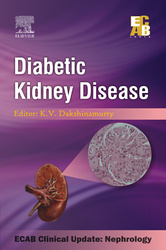「重要なお知らせ:日本語書籍をご購入いただき、eLibraryをご利用の皆さまへ」
エルゼビアは、より快適にサービスをご利用いただくため、システムの重要なアップデートを実施いたします。
現在、新サイト、eBooks+への移行が進められています。
新規ユーザー登録および書籍の登録はElsevier eLibraryでは停止しております。
12月15日以降に
こちらよりご利用・ご登録ください。
Book Description
The prevalence of Diabetes Mellitus is increasing rapidly all over the world and more so in the developing countries. The global burden of diabetes is expected to double between 2000 and 2030, with the greatest increases in prevalence occurring in the Middle East, sub-Saharan Africa and India. Moreover, the development of type 2 diabetes during the childbearing years is also likely to increase, primarily in the developing countries. It has already been established that Diabetes is the most common primary cause leading to end stage renal disease (ESRD) and Diabetic Nephropathy is the leading cause of chronic kidney disease (CKD) in India.
The cornerstones of management of Diabetic Kidney Diseases include early diagnosis of diabetic nephropathy, prevention of its progression and treatment of the co-morbid conditions. Substantial under-diagnosis of both diabetes and chronic kidney disease leads to lost opportunities for prevention. An inadequate or inappropriate care of patients with diabetic kidney disease contributes to disease progression eventually up to a stage that requires renal replacement therapy, which is not a feasible option for many on a long-term basis, especially in a developing country like ours.
This book covers various aspects of diabetic kidney disease in detail and attempts to familiarize the reader with the existing aspects of the conditions as well as touch upon the new advances in the field. The first chapter outlines the extent to which the condition affects the population globally as well as in our country. The second chapter explores the underlying mechanism by which the disease starts and progresses and the pathological markers of the same. The third chapter delineates the clinical and diagnostic markers of the condition. The fourth and fifth chapters speak of the non-diabetic glomerular and non-glomerular diseases in diabetics. The sixth chapter addresses the most important and desirable goal of preventing the progression and ideally the onset of the disease. The seventh chapter puts together the various treatment modalities available and the subsequent chapter explores the management options for cases requiring renal replacement. In addition to the emphasis to Indian literature at the end of each chapter, the ninth chapter is specially included to highlight the salient aspects of this condition from the Indian perspective.
This book will be beneficial not only for the nephrologists, but also for the epidemiologists, medical students, diabetologists and every doctor who deals with diabetes mellitus.


 (0 rating)
(0 rating) 





